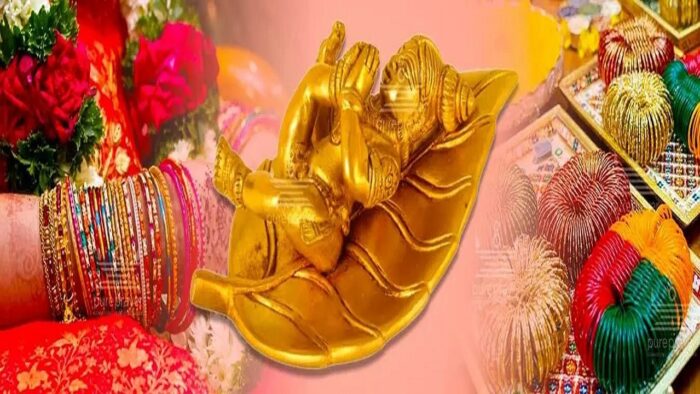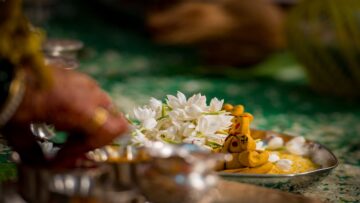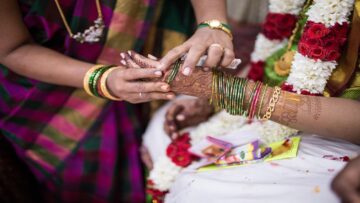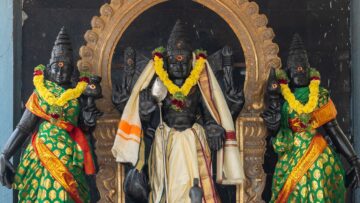Introduction
Puṃsavana = A protocol with certain guidelines to beget a healthy child. Now, we shall explore about Puṃsavana Saṃskāra and Puṃsavana Karma along with Sīmantonnayana Saṃskāra.
Puṃsavana Saṃskāra = A ritual that must be done once for each pregnancy with Vedic or Purāṇic mantras. One important step of this ritual involves the procedure called Nasya (a commonly used Āyurvedic treatment method where medicine is administered through the nostrils). Let us focus on some pre-op steps that are necessary for the Saṃskāra.
Steps for collecting the plant/tree materials
First, we need to collect some materials for the Saṃskāra.
As a common rule, follow the instructions given in Caraka Samhitā[1] for the collection of medicinal plants or tree materials. Though there are other rules, this will suffice for the general public.
The plant or tree must have the following characteristics –
- Grown/cultivated at the proper time. Must be in fresh condition at the time of collection.
- Taste, potency, colour, and smell must be unaffected. (Must not cause discomfort to the body due to pathogens affecting them).
Step 1 – Take a bath.
Step 2 – Wear clean, white-coloured clothes (traditional ones are preferred).
Step 3 – Worship Bhagavān and do a Sāṣṭaṅga/Pañcāṅga Namaskāra.[2]
Step 4 – Chant Bhagavān Nāma or ślokas and walk a few steps in the Northern or Eastern direction. (There must be no comprise in this, every plant/tree has a Guardian Devatā protecting the whole structure along with its medicinal properties).
Step 5 -Proceed to the place of collection. (This is done to nullify any doṣas (bad effects) that may occur by harming the flora/plant life).
The Ideal Time
During Brāhma Muhūrta (the 14thMuhūrta of night-time)
If the sunrise is at 7 a.m. then Brāhma Muhūrta is from 5:24 to 6:12 a.m. Online Pañcāṅga websites or apps also give precise timing as per your location. (1 Muhūrta= Approx. 48 mins)
During the 15th Muhūrta also, collection can be done. Till Saṅgava Kāla[3], it will be effective. But for maximum benefits, BrāhmaMuhūrta is the best time slot. Interestingly, if you had seen big corporate companies involved in this matter, they always encourage the workers to collect during BrāhmaMuhūrta or before sunrise. More details will be found online.
After Saṅgava Kāla also, it is not advisable. After sunset, it is strictly avoided.
In Puṃsavana Saṃskāra, collection of only one item is required – the leaf buds of a banyan tree grown near a Gośāla (cowshed). The leaf buds must be collected from a branch facing the eastern or northern direction.
This common rule can be followed for collection in general, for plucking fruit or collecting Bilva leaves, etc.
Steps in Puṃsavana Saṃskāra (This is a summary of the protocol from the Smṛtis)
The first session
Step 1 – NāndīŚrāddha before the day of Puṃsavana Saṃskāra. (Explained a bit later in this article).
Step 2 – UdakaŚānti– here, a Kumbha filled with sacred water is sanctified with mantras. Then the pregnant lady must be surrounded by a minimum of four purohits (each of them must sit in one place) and must recite mantras or stotras for a muhūrta.
Step 3 – The leaf bud of the banyan tree must be squeezed by a girl belonging to the same family or gotra. (Preferably, a girl who is below 10 years of age or has not attained menarche.)
Step 4 –The girl must squeeze the leaf bud with a khalva[4] (the stone slab that is used in traditional rituals – ammikal) to extract the liquid inside, filter the liquid with a clean white cloth and it can be mixed with a few drops of cow’s milk.
Step 5 – The pregnant lady must preferably lie down in a supine position (face facing the ceiling) or sit in a reclined position. The lady initially must gently breathe out with her mouth and nostrils then relax with gentle inhalation and exhalation. While the drops are administered, she must inhale.
Step 6 –The husband and wife can practise this beforehand with 2 drops of sesame oil administered in each nostril. (The comfort of a wife is of utmost importance as sometimes at the time of the Nasya she may end up spitting up the milk if the instructions are not followed properly).
It should be noted that some individuals can even get a peculiar taste in the throat after administration of eye drops, nasal drops, etc. This is not abnormal and hence not a reason to be anxious.
Step 7 – The husband[5] of the pregnant lady must instil a few drops of the leaf bud extracted liquid (which is mixed with a little quantity of cow’s milk) (maximum of 3-5 drops should suffice). The administration must be done with the thumb into the right nostril.[6] The husband must recite the mantras as told by the purohit simultaneously.This step is important and must be done during the suitable Muhūrta. Care must be taken to ensure that the lady does not get the urge to spit. (If instructions are carefully carried out, this problem will not occur).
Step 8 – The lady can relax for a minute or two while lying down.
Step 9 – Homa with some samit sticks. (This is also a very important ritual).
Brahmā, the creator of us all is appeased by this Homa. We request Him to safeguard the child from blemishes and bestow good characteristics.
The above 9 steps are involved in the first session as per the Lagna determination during daytime.
The second session
The second session must happen in the evening time of the same day. Ideally Veena should be played by someone in attendance as the soothing music emanating from this instrument is said to be equally powerful as the sound of Veda hymns, Itihāsa and Purāṇas.
But if not for the Veena then any music dedicated to the river that is in vicinity can be played initially followed by any other music related to Bhagavān.
हारिगीतंहिमोऽनिलः।
AṣṭāṅgaHṛdayaSūtraSthāna– 13/6
Music in general is beneficial for the body and mind. Especially, one’s pitta or pitta regulated functions like eyesight, thinking, blood flow, etc. are soothed by music. Cool breeze and pleasant music are capable of pacifying pitta, if pitta is under control, then the blood-related disorders can also be pacified to a large extent. (This music may serve to help the functions of blood).
Sīmantonnayana Saṃskāra
Sīmantonnayana = Sīmanta + unnayana.
Sīmanta = An area on the scalp.
Unnayana= Separating or parting of the hair into two halves.
Sīmantonnayana is also a short Saṃskāra, which we shall explore .
श्रुति-सीमन्त-सिन्दूरी-कृत-पादाब्ज-धूलिका।
LalitāSahasranāma 68
Sīmanta is very important. Even Ambika’s hair is described to have the parting to denote motherhood.
Sīmantonnayana is only for the first pregnancy, not for every pregnancy. This Saṃskāra is for allowing the pregnant lady to get a special blessing from Bhagavān by activating the Sīmanta Marmā. (A line is drawn from the anterior end to the posterior end with the items stated to activate a hidden special point in the scalp).[7]
Step 1 – The following items are to be collected – (The purohit will carry these.)
A porcupine’s quill having a white spot in three areas,[8] Ficus carica (unripe fig) fruits, Darbha grass, and grains without the husk removed.
Step 2–These items are taken, and a line must be made over the scalp medially from the anterior end to the posterior end. This step is important and must be done during the suitable muhūrta.
Step 3 – Then Āśīrvāda (blessings) must be bestowed on the couple.
Step 4 – The wife and husband must observe Mauna Vrata/silence[9] till the Nakṣatras are visible in the night. Both must involve themselves in any activity related to Bhagavān. Mauna involves no texting and no writing as well. But most importantly words should not be uttered.
Mauna is often linked to better memory retention power and mental prowess in Śāstras.
Step 5– Then once the Nakṣatras are visible, the couple must worship and touch a Vṛṣabha/bull (one which is not castrated). Mauna Vrata is completed.
Thus, Sīmantonnayana is concluded.
Vṛṣabha[10] here is a symbolic representation of Dharma, good physical strength, and even mental strength. Bull by itself denotes very good physical strength. At the same time, mental strength is also denoted. As per Jyotiṣa, the strength of Candra Bhagavān is at its peak and second-best strength while in Vṛṣabha Rāśi.
Note –Valaikappu or any regional celebration of the pregnant lady can be done on any auspicious day or the same day of Sīmantonnayana Saṃskāra without causing any hindrance to the Saṃskāra (the vow of silence must be observed, and certain edibles/beverages are to be avoided).
Nāndī Śrāddha
Before undertaking any important task, we must be adequately prepared for any kind of challenge ahead. Śāstras mention that the following three must always be appeased – Devatās, Ṛṣis, and Pitṛus. An important step that is often overlooked is Nāndī Śrāddha and a separate day must be dedicated to this karma. Nāndī Śrāddha must be done before Vivāha, then again separately before Garbhādhāna to seek the blessings of Pitṛus. Pitṛus have a bigger role than the Devatās in strengthening one’s progeny. The Pitṛus involved in Nāndī Śrāddha here are called Śobhana Pitṛus who ensure that fortune and luck always prevail.
Pitṛus do not necessarily mean dead relatives or ancestors; they are a class of Devatās responsible for many things, and among those things, they have the power to‘veto’ and protect one’s lineage.
This is how the Saṃskāras must happen. (The duration and rituals change for different Sampradāyas but overall, the basic procedures will be similar).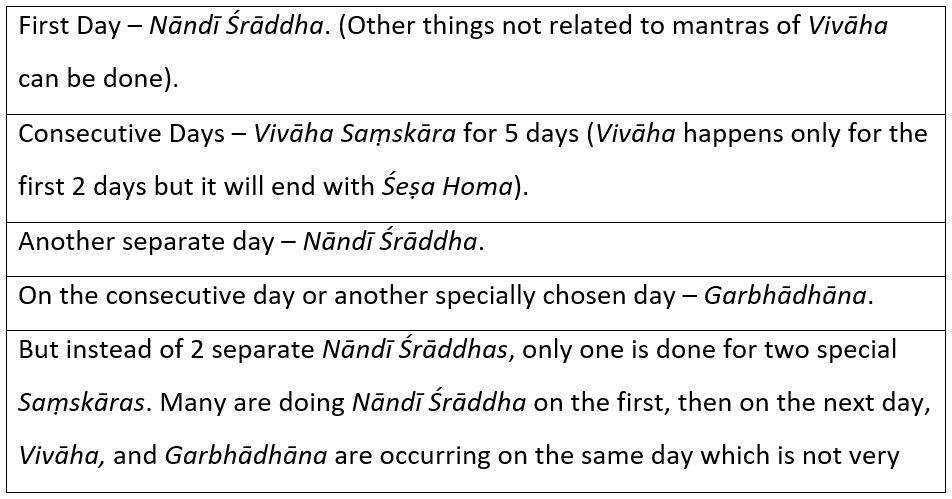
Nāndī Śrāddha is a very important function that has a proper protocol that must not be rushed to suit our convenience. People may be concerned about the cost of these rituals, however one need not invite a big crowd for these rituals. Anna-dāna must be done specially on certain occasions like Vivāha, to the best of one’s ability.
Puṃsavana Karma
Puṃsavana Karma = The methods or diet or medicines prescribed in Āyurveda and other Śāstric texts. This is for conception as well as for safeguarding the fetus.
There are many methods explained in the Āyurvedic Saṃhitās, but these are medical textbooks. If one is interested in prenatal care with Puṃsavana, please contact any Āyurvedic physician acquainted with this (to avoid the wrong herbal ingredients from being used)
Nasya methods have been advised like the one mentioned in the Saṃskāra. But the ritual part and music session are not mentioned. For Saṃskāra, special mantras were used, but here as a Karma, Nasya can be done occasionally while reciting Bhagavān Nāma or ślokas.
DIY (Do It Yourself)
Many DIY (Do It Yourself) Puṃsavana Karmas are given.
How did Prahlāda become a gentle person? He was the son of an asura (Hiraṇyakaśipu). It is all because of Nārada’s blessings in the form of teaching from various stories, Veena-Gāna and Satsaṅga for Kayādhu (Prahlāda’s mother) while she was pregnant under Nārada’s protection from Indra. Indirectly, Nārada had been performing Puṃsavana Karmas, because Kayādhu was weary, anxious, and frightened (fear affects the baby very seriously).
Nasya is a tedious step; other things can be done with ease, like hearing Veena music or any traditional music, doing naivedya of curd rice/plain curd during daytime (hot rice and curd should not be mixed, mixing must be done after the rice’s warmth comes down)[11] to Guru Bhagavān (Putra Kāraka – the one responsible for progeny) or any Bhagavān. (Curd + rice is the favourite food of Guru and is mentioned in some karmas).
All Karmas that are mentioned for infertility can be used in Puṃsavana. The methods are innumerable; even a recital of Lalithā/Viṣṇu/Śiva Sahasranāma (even any one of the thousand names can be recited repeatedly) or Kamba Rāmāyaṇam or even regional language stotra can be considered as Puṃsavana Karmas as they secure good things for the fetus.
Another important statement that has been mentioned is – any measures suggested by Brāhmaṇas with Vedic/Śāstric knowledge, experienced people (like physicians, astrologers, etc.), and ladies with experience can also be followed.[12]
Time for Puṃsavana and Sīmantonnayana
Puṃsavana Saṃskāra – After confirmation of pregnancy, either during 2nd or 3rd month can be done for each pregnancy.
Puṣya Nakṣatra is the most preferred Nakṣatra, but if unable to do so for any reason, then Saṃskāra can be done on any of these Nakṣatras – Hasta, Mūla, Punarvasu, Mṛgaśīrṣa, and Śravaṇa. Śubhamuhūrta or Lagna must be chosen.[13]
ŚubhaMuhūrta/Lagna is important for the Nasya in Puṃsavana Saṃskāra and for parting the hair in Sīmantonnayana Saṃskāra.
Doing it during the 2nd or 3rd month is ideal, but this can be done before Sīmantonnayana even in the 4th month.
Puṃsavana Karma – There is no hard and fast rule here. The Nasya part is done with mantras and Veena belongs to Saṃskāra. This can be done on any of the above-mentioned Nakṣatras on a Śubhamuhūrtaor any Śubhakāla or at any convenient time (except for the Nasya) mentioned in the Pañcāṅga.
Sīmantonnayana Saṃskāra – In the 4th or 6th or 7th month. (3rd and 5th months are also given. Please follow your Saṃpradāya. Śubhamuhūrta or Lagna must be chosen. Sīmantonnayana Saṃskāra is done only once.)
As a last resort for Sīmantonnayana Saṃskāra, if the childbirth has happened without performing the Saṃskāra, theSaṃskāra can be carried out with the child handed over to a relative while the Saṃskāra happens.
Puṃsavana Vrata will be covered in the next part.
… To be continued.
References
[1]तत्रयानिकालजातान्युपागतसम्पूर्णप्रमाण-रसवीर्य-गन्धानिकालातपाग्निसलिलपवनजन्तुभिरनुपहतगन्ध-वर्ण-रस-स्पर्श-प्रभावाणिप्रत्यग्राण्युदीच्यांदिशिस्थितानि; तेषांशाखापलाशमचिरप्ररूढंवर्षावसन्तयोर्ग्राह्यं, ग्रीष्मेमूलानिशिशिरेवाशीर्णप्ररूढपर्णानां, शरदित्वक्कन्दक्षीराणि, हेमन्तेसाराणि, यथर्तुपुष्पफलमिति; मङ्गलाचारःकल्याणवृत्तःशुचिःशुक्लवासाःसम्पूज्यदेवताअश्विनौगोब्राह्मणांश्चकृतोपवासःप्राङ्मुखउदङ्मुखोवा गृह्णीयात्॥१०॥CarakaSamhitā.Kalpa Sthāna.1/10
[2]Complete prostration for men and partial prostration for women. Pañcāṅga Namaskārafor women.
[3]The first 2 hours and 24 mins after Sunrise = Prātaḥ Kāla. The second slot of 2 hours and 24 mins = Saṅgava Kāla.
[4]An apparatus used for grinding traditionally.
[5]Substitutes in absence of the husband – Father, Brother, Father-in-law, Brother-in-law, etc. Please consult the family’s Guru on this matter.
[6]The administration must be inside the right nostril for the first pregnancy and can be given in the left nostril (if a girl child is desired) in consecutive pregnancies.
[7]There are slight variations with the Saṃskāra in this aspect, but all are the opinions of Ṛṣis.
[8]This is used only after purification; animal-origin brushes like boar brushes, squirrel brushes, etc. were used in our country also but only after purification.
[9]Must not involve in entertainment or pleasure activities while observing silence. Complete cessation of words is required. This vow of silence is said to boost the memory and intelligence of the conceived child.
[10]Whenever a procession of Bhagavān is happening nearby, these two Vāhana Alaṅkāras – Vṛṣabha Vāhana and GaruḍaVāhana must be witnessed as they catalyse the process of attaining mokṣa. Vṛṣabha= personification of Dharma and Garuḍa= personification of Vedas.
[11]Curd must not be taken at night. Even while consuming curd, it must be mixed with a little quantity of salt or ghee or sugar or green gram soup or honey or amla fruit. Otherwise, it will cause diseases. Usually, a little salt is added to rice and mixed with curd and water. In certain conditions, curd must not be consumed. It can be converted to buttermilk and then consumed.Curd and urad dal (usually vada) should not be eaten together.
[12]Caraka SamhitāŚārīraSthāna8/19
[13]The family Purohit/Vadyār will take care of these timings.
Disclaimer: The opinions expressed in this article belong to the author. Indic Today is neither responsible nor liable for the accuracy, completeness, suitability, or validity of any information in the article.

